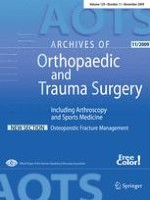Published in:

01-11-2009 | Trauma Surgery
Fractures of the scapula: long-term results after conservative treatment
Authors:
Markus D. Schofer, Axel C. Sehrt, Nina Timmesfeld, Sabine Störmer, Horst R. Kortmann
Published in:
Archives of Orthopaedic and Trauma Surgery
|
Issue 11/2009
Login to get access
Abstract
Introduction
The aim of this study was to determine the long-term prognoses for conservatively treated fractures of the scapula.
Materials and methods
Ascertainment of functional long-term results in 50 patients treated for a total of 51 scapular fractures in a retrospective cohort study with an average follow-up period of 65 months.
Results
The breakdown of these scapular fractures was as follows: simple (22%) and fragmented (51%) fractures of the scapular body, fractures through the scapular neck (41%), fractures of the coracoid process, spine and acromion of the scapula (10%) and glenoid fractures (8%). In 17 of these cases of scapular fracture two or more types were present. At the follow-up examination a restricted range of movement was found in all directions. In abduction, flexion and external rotation the range of motion on the affected as against the unaffected side was significantly restricted, but the observed restriction did not substantially affect the functional results. The Constant score on the affected side was 79 points, with 23% very good, 51% good, 20% satisfactory and 6% poor results. Isokinetic testing carried out on both sides for comparison revealed lower peak torque values and lower mean power output in all planes of movement, and lower speeds on the affected side. There was a correlation between extent of restriction on movement and diminution of isokinetic muscular strength. Determination of the external rotation is recommended as a clinical test value, as it highlights significant deficits both in restriction of range of motion and in isokinetic test measurements. The outcome of treatment was not influenced by fracture type, associated injuries or handedness.
Conclusion
After conservative treatment, scapular fractures heal with a good functional result despite measurable restrictions.